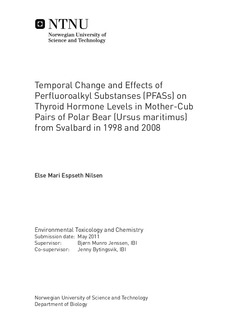| dc.description.abstract | High levels of persistent organic pollutants (POPs) have been detected in the Arctic wildlife. While many of the traditional POPs have been reported to decline the last decades, emerging contaminants such as perfluoroalkyl substanses (PFASs) have been detected in increasing amounts in biota worldwide. PFOS has been the major PFASs detected and the leading manufacturer of PFOS announced a voluntarily phase-out of the perfluorooctanesulfonyl fluoride (POSF) chemistry and ended the production in 2002. However, other PFASs are still being used in the industry and no regulations have been established. The toxicological effects of PFASs are not fully elucidated, but they have been linked to hepatotoxicity, developmental toxicity, immunotoxicity and disruption of hormone homeostasis.The aim of this study was to investigate temporal changes of PFASs and to evaluate possible relationships between PFASs and circulating thyroid hormone (TH) levels in polar bear (Ursus maritimus) mother-cub pairs from Svalbard sampled in 1998 (12 mother-cub pairs) and 2008 (9 mother-cub pairs). Plasma samples from all polar bears were extracted by liquid-liquid extraction (LLE) using methanol and analysed for perfluorobutanoic acid (PFBA), perfluoropentanoic acid (PFPeA), perfluorohexanoic acid (PFHxA), perfluoroheptanoic acid (PFHpA), perfluorooctanoic acid (PFOA), perfluorononanoic acid (PFNA), perfluorodecanoic acid (PFDA), perfluoroundecanoic acid (PFUnDA), perfluorododecanoic acid (PFDoDA), perfluorotridecanoic acid (PFTrDA), perfluorotetradecanoic acid (PFTrDA), perfluorobutane sulfonate (PFBS), perfluorohexane sulfonate (PFHxS), perfluorooctane sulfonate (PFOS) and perfluorooctane sulfonamide (PFOSA) using liquid chromatography mass spectrometry (LC-MS). Total thyroxine (TT4), free thyroxine (FT4), total triiodothyronine (TT3) and free triiodothyronine (FT3) were quantified by the use of radioimmunoassay (RIA). Relationships between PFASs, THs, age (only mothers), capture day and biometric variables were investigated by the use of principle component analysis (PCA) and general linear models (GLM).PFHpA, PFOA and PFOS showed significant decreasing levels in mothers, while the levels did not differ between the years in cubs. In contrast, the longest chain perfluorinated carboxylic acids (PFCAs) showed significantly increasing concentrations over time in both mothers (PFNA, PFUnDA, PFDoDA, PFTrDA) and cubs (PFNA, PFDA, PFUnDA, PFDoDA, PFTrDA, PFTeDA). Concentration of PFBA, PFPeA and PFHxA were not detected in mothers or cubs, PFBS was detected in one mother and PFOSA was only detected sporadically. A positive relationship was observed between the longest chain PFCAs and TT3 in both mothers and their offspring, particularly with regard to PFTrDA in mothers and PFDoDA in cubs. In addition, TT3 and body mass were positively correlated in cubs. In contrast to the longest chain PFCAs, no relationships were observed between PFOS and THs in the polar bear plasma samples. The positive correlation between TT3 and the longest chain PFCAs may indicate a possible interaction between PFCAs and the TH homeostasis in polar bear mother-cub pairs. However, no final conclusions can be drawn based on the mechanism behind this finding and further research is needed on these emerging contaminants to elucidate their potential TH-disrupting effects. | nb_NO |

